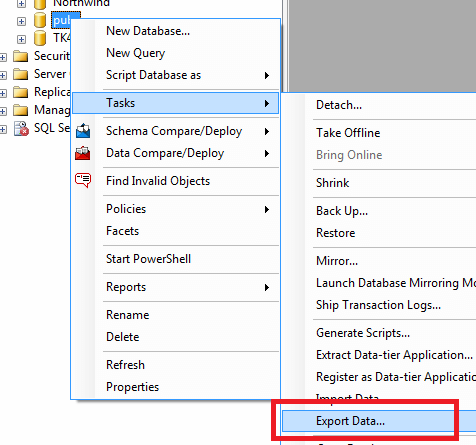

- #Sql 2012 express export db how to
- #Sql 2012 express export db install
- #Sql 2012 express export db full
Pay attention to the fact that there might exist users in the database that have got the same names as the ones on the new server but have got different principal SIDs. What you probably need to do now, is to configure the appropriate permissions for the users of your database. Any data that was entered after the last backup is lost.
#Sql 2012 express export db install
If there is no other SQL Server available, you obviously need to install one on another computer. It is not possible to restore a database backup on another SQL-Server running an older version than the one the backup was created on. That server needs to run the same or a newer version of SQL-Server. The first thing to do now is to find another SQL-Server that can host your database, at least temporarily. So there is a recent backup available to restore. Furthermore, we assume you prepared for this and copied your backups to another location. Bad things do happen.įor the sake of this example, we assume the computer running your SQL Server failed and the actual database files cannot be recovered. That being said, I actually had a situation with a second disk in a RAID failing within 48 hours after the first and before the first one was replaced. Storing your database on a RAID greatly reduces the risk of such an event leading to data loss. Assume the hardware, most likely the hard disks, of your SQL-Server computer failed and the database is corrupted or lost entirely. Here is the first of the two scenarios we are going to look at. There are two different, common scenarios that will require you to restore a database. You’ll fire up SQL Server Management Studio and restore the database manually. A restore operation usually isn’t something you are going to automate. If your backup was done properly, the actual restore of a database should not be much of a problem.
#Sql 2012 express export db how to
Furthermore, you should know exactly how to do this. You need to be sure it is actually possible to restore the data from the backup back to working condition. Backups on their own are not worth anything.


Let’s get started with an old sysadmin-proverb: “Nobody wants backup, everybody wants restore!” – There is an essential truth in this. That is beyond the scope of this article. If you are responsible for a huge database on a “bigger” edition of SQL Server, you should be familiar with the restore of individual files and filegroups and the transaction log as well.
#Sql 2012 express export db full
However, as the focus of the series is on SQL Express Edition, I will cover only how to restore a complete database from a full or differential backup. What is covered here, is basically valid for all SQL Server Editions. You should be at least familiar with the fundamentals of backup before continuing to read about restoring databases. The previous articles covered the fundamentals of SQL Server Backups and the implementation of automatic backups on SQL Express. This final article in this series about backups of your Microsoft SQL Express database wraps up the topic by explaining how to restore a database from a backup created earlier. By Philipp Stiefel, originally published March 9 th, 2017īased on a photo by russ101, used here under CC0 licensing


 0 kommentar(er)
0 kommentar(er)
